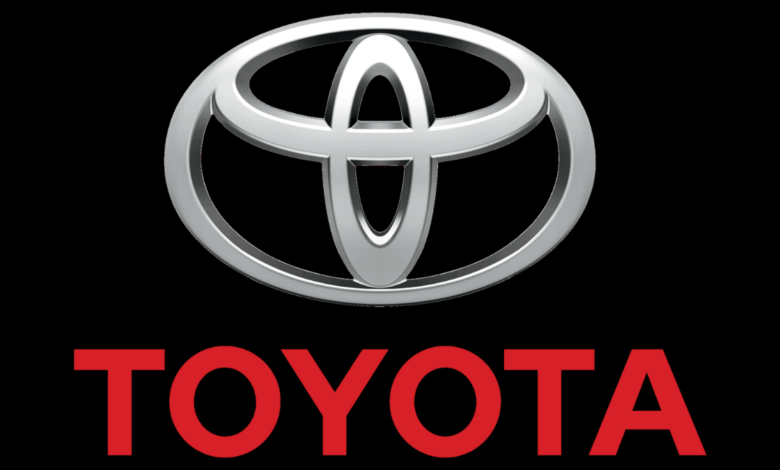Toyota Logo: Symbolism, History, and Evolution Behind One of the World’s Most Recognizable Emblems

The Toyota logo is one of the most recognizable automotive symbols in the world, a brand that has become synonymous with quality, innovation, and reliability. But have you ever wondered about the deeper meaning behind the Toyota logo, how it evolved over time, or how it has contributed to the company’s success? In this article, we’ll dive deep into the Toyota logo’s fascinating history, its design symbolism, and how it has become an integral part of Toyota’s global identity.
1. Introduction to the Toyota Logo: What Does It Represent?
The Toyota logo is more than just a simple design — it carries deep symbolism and a long history that reflects the company’s core values. Created with thoughtful precision, the logo represents Toyota’s commitment to technological advancement, quality, and customer satisfaction. At its core, the Toyota logo consists of three overlapping ellipses. But why these specific shapes, and what do they really mean?
The Three Overlapping Ellipses
At first glance, the Toyota logo looks like a basic geometric design — three ellipses arranged in a specific pattern. The outermost oval represents the global expansion and the company’s broad reach across international markets. The two inner ellipses, which intersect with the larger one, signify the company’s customer-centric approach. One of the inner ellipses represents the heart of the customer, while the other symbolizes the company’s dedication to creating a sense of unity and trust between Toyota and its consumers. This clever interplay between the shapes embodies Toyota’s commitment to creating products that resonate with their users while also positioning the company as a global leader in the automotive industry.
A Hidden “T”
Many people may not immediately recognize that the logo subtly incorporates the letter “T,” which stands for Toyota itself. This hidden “T” is formed by the overlapping of the ellipses, reflecting the integration of the company’s identity within its products and services. This symbolic letter is a reminder of Toyota’s pioneering spirit and its focus on innovation, as well as its reputation for crafting vehicles that have become an integral part of the lives of millions of drivers around the world.
A Circle of Trust and Technology
Another key aspect of the Toyota logo is the way the design evokes a sense of trust and technology. The smooth curves of the ellipses suggest a sense of continuity and motion, elements that are core to the automotive world. As one of the leading car manufacturers globally, Toyota’s logo reflects the idea of constant movement — both literal and figurative. It symbolizes the company’s ability to keep evolving, moving forward with technology, and offering customers products that meet and exceed their expectations. The perfect balance between the technological advancement in the design and its message of trust is one of the reasons why Toyota has become a household name across generations.
2. The Origins of Toyota: A Legacy of Innovation and Quality
The Toyota logo didn’t appear overnight. To understand its evolution, it’s important to first take a step back and look at the origins of the company itself. Toyota was founded in 1937 by Kiichiro Toyoda, a visionary industrialist and engineer. However, the history of Toyota as a brand began even earlier, with Kiichiro’s father, Sakichi Toyoda, who revolutionized the textile industry with his invention of automatic looms. Kiichiro’s transition from textiles to automobiles was part of a broader effort to create a modern, self-sufficient manufacturing empire that could rival Western competitors.
The Birth of the Company
In the early days, Toyota was a division of the Toyoda Automatic Loom Works. The company first began to explore the automotive industry after Kiichiro Toyoda visited Europe and the United States in the early 1930s. He was deeply inspired by the advanced automotive technologies he saw abroad and returned to Japan with a vision to create a domestic automobile industry. In 1936, Toyota developed its first passenger car, the Model AA, which was based on the Chevrolet design. The Model AA helped establish Toyota’s position in the automotive industry, setting the stage for the company’s logo to emerge years later as a symbol of Japanese automotive prowess.
The Transition to Toyota Motor Corporation
In 1937, Toyota formally split from its parent company and became an independent automaker. During this period, Toyota had already begun experimenting with designing its own vehicles, and by the time World War II ended, Toyota had already started establishing itself as a leader in automobile production. In the early 1950s, after successfully navigating the post-war recovery period, the company realized it needed to develop a distinct visual identity to distinguish itself from both its competitors and its own historical ties to the loom industry.
3. The Evolution of the Toyota Logo: From 1930s to Today
The Toyota logo has undergone significant changes over the years, much like the company itself. It began as a more literal symbol but has transformed into the streamlined, sophisticated design we recognize today. Let’s take a look at how the logo evolved over time.
The Original Logo: 1930s
When Toyota first started producing automobiles, its logo was quite simple. The original logo was based on the Toyoda family name, which was written in Japanese kanji characters as “豊田.” However, as Toyota’s global presence began to grow, it became clear that a more universal, recognizable symbol would be necessary. In 1936, the company transitioned from using kanji to a more recognizable Latin-letter-based logo, which helped align the brand with international standards.
The First Toyota “T” Logo: 1936 to 1989
The very first Toyota emblem was an emblem featuring the name “Toyota” written out in a cursive script. The “T” letter in the design was stylized, and the name itself was surrounded by various elements that gave the logo a more ornamental, almost “vintage” feel. It was clear that the emblem was designed to give the brand a sophisticated, high-end image, matching its ambitions of becoming a leader in global automobile manufacturing. However, over time, this script-based logo was deemed a bit too traditional, and with the company’s rapid expansion, a more modern and sleek logo was needed to convey its forward-thinking, innovative spirit.
The Current Toyota Logo: 1989 to Present
In 1989, Toyota officially launched the current logo that we are all familiar with today. The updated design features three interlocking ellipses that make up a sophisticated and modern representation of the brand. This logo marked a clear departure from the previous designs and reflected Toyota’s commitment to both innovation and continuity. The launch of the new logo came at a time when Toyota was establishing itself as a global force in the automotive industry, especially in markets like the United States and Europe.
This new design signified Toyota’s broadening of its global scope, and it was far more versatile in how it could be used on various products, advertisements, and digital platforms. The simplicity of the new logo allowed it to be scaled easily, printed clearly, and replicated across countless materials, while still maintaining its symbolic significance. The combination of the three ellipses and the hidden “T” within them made it a design that was both iconic and memorable.
4. Why the Toyota Logo Works: The Psychology of Simple Designs
One of the reasons the Toyota logo is so effective is its simplicity. Let’s look into the psychological power of minimalistic design and how it has contributed to the logo’s success in establishing an emotional connection with customers.
The Power of Simplicity
Psychologically, people are drawn to simplicity. A simple logo is easier to remember, more versatile, and often communicates a sense of clarity and trust. The Toyota logo, with its smooth curves and clean lines, feels approachable and trustworthy. The three ellipses evoke a feeling of unity and motion, aligning perfectly with the values of Toyota as a company — forward-thinking, reliable, and adaptable.
Memorability and Recognition
Another key psychological principle behind the success of the Toyota logo is its memorability. The logo’s geometric design, with the subtle “T” hidden within, creates a visual experience that sticks in the minds of viewers. It’s an iconic symbol that is immediately recognizable, even from a distance or on small devices like mobile phones. For a brand to succeed, it needs to create a mental shortcut that allows consumers to instantly recognize it, and Toyota has done this masterfully with its logo.
Emotional Connection
The Toyota logo also works on an emotional level. The interplay of shapes and smooth, continuous lines creates a feeling of stability and harmony. This gives the impression that the company cares about both its customers and the environment. For many, the Toyota brand is associated with reliability, longevity, and a sense of safety, and the logo itself reinforces these associations.
5. The Global Impact of the Toyota Logo: A Universal Symbol
Toyota is a global brand, and its logo plays a huge part in its universal recognition. Whether you’re in the U.S., Japan, Germany, or South America, the Toyota logo communicates the same values: trust, quality, and cutting-edge innovation. But how has the logo helped the company maintain its global position as a leader in the automotive industry?
A Universal Appeal
One of the secrets behind the success of the Toyota logo is its universal appeal. The logo transcends cultural boundaries and speaks to people across the world. The design, which relies on simple geometric shapes and no complicated text or symbols, allows it to be understood and appreciated by people in different countries, with varying linguistic and cultural backgrounds.
Brand Consistency Across Borders
Toyota has made great efforts to maintain brand consistency across all of its markets. Whether the company is producing vehicles in Japan or marketing them in the U.S., the Toyota logo remains the same. This consistency in branding reinforces the company’s image as a reliable, high-quality automaker that delivers the same experience, no matter where in the world you’re located.
Cultural Adaptability
While the Toyota logo itself remains the same, Toyota has also adapted its marketing strategies to fit the cultural nuances of various regions. In some markets, Toyota emphasizes the reliability and family-friendly nature of its vehicles. In others, it might focus on environmental sustainability or cutting-edge technology. The adaptability of the Toyota brand has been a key factor in its success, and the logo itself has played a central role in this global strategy.
6. The Future of the Toyota Logo: Evolving with the Times
As Toyota continues to innovate and grow, what does the future hold for the Toyota logo? Will the design evolve, or will it remain timeless? The company has made it clear that its focus remains on maintaining its core values while embracing new technologies and future mobility solutions, including electric and autonomous vehicles. In the coming years, it is possible that we may see slight updates to the logo to reflect these advancements.
The Role of Technology and Sustainability
In the future, Toyota’s logo might be used in ways we can’t even imagine today. With the rise of electric and autonomous vehicles, the company will continue to adapt to new technologies and environmental concerns. The logo might evolve to include elements that better reflect Toyota’s commitment to sustainability and the future of mobility. However, one thing is for sure — whatever the changes, the core elements of the logo will likely remain the same. After all, the Toyota logo has proven itself to be not just a symbol, but an enduring representation of the company’s values and mission.
Conclusion: The Enduring Legacy of the Toyota Logo
From its humble beginnings in the textile industry to becoming one of the world’s leading automakers, Toyota’s logo has played a significant role in the company’s success. With its simple yet meaningful design, the Toyota logo continues to represent the company’s commitment to quality, innovation, and customer satisfaction. Through its evolution, the logo has mirrored Toyota’s journey, from a Japanese automaker to a global powerhouse. Whether you are driving a Toyota car today or simply encountering the logo in a commercial, it’s a reminder of the company’s vision, and its ongoing drive to improve the way we live and move.
In the future, the Toyota logo will likely continue to evolve, but its core message will remain the same: reliability, trust, and forward-thinking innovation. As Toyota continues to adapt to the changing automotive landscape, its logo will undoubtedly remain a symbol of progress, integrity, and quality for generations to come.





